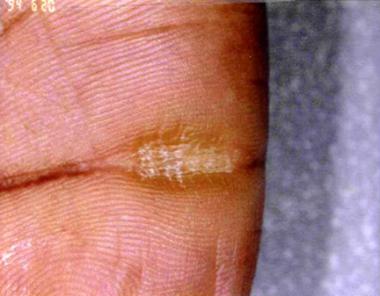

A clavus is a thickening of the skin due to intermittent pressure and frictional forces. These forces result in hyperkeratosis, clinically and histologically. The extensive thickening of the skin in a clavus may result in chronic pain, particularly in the forefoot; in certain situations, this thickening may result in ulcer formation. The word clavus has many synonyms and innumerable vernacular terms, some of which are listed in the Table below; these terms describe the related activities that have induced clavus formation.
Synonyms for clavus include callosity, a hyperkeratotic response to trauma; corn, heloma, or a circumscribed hyperkeratotic lesion that may be hard (ie, heloma durum) or soft (ie, heloma molle); and callous, callus, or a diffusely hyperkeratotic lesion. Localized callosities of the soles, which do not resolve, are termed plantar callus, heloma, tyloma, keratoma, or plantar corn.[1] When callosities occur over 1 or more lateral metatarsals, they are termed intractable plantar keratoses.[2]
Clinically, all these lesions look like hyperkeratotic or thickened skin. Maceration and secondary fungal or bacterial infections are a common overlying feature in heloma molle and diabetes. Plantar helomas tend to have a central keratin plug, which, when pared, reveal a clear, firm, central core. The most common sites for clavus formation are the feet, specifically the dorsolateral aspect of the fifth toe for heloma durum, in the fourth interdigital web of the foot for heloma molle, and under the metatarsal heads for calluses.[3]
Table. Clavus Formation Named for Specific Etiology or Location (Open Table in a new window)
Vernacular Term Location Association Jeweler's callus, cherry pitter's thumb,[4] cameo engraver's corn[5] Thumb Digital changes, including callosities related to repetitive use of fine jeweler's instruments, which also may be seen with the use of cherry-pitting tools Weight lifter's callus[6] Callosities over the palmar metacarpophalangeal joints Caused by the friction of weight-lifting apparatus (This also may be seen in athletes who participate in crew.) Prayer callus[7, 8] Callosity on the forehead From kneeling prayer with the hands on the forehead Cigarette lighter's thumb[9] Hyperkeratosis of the radial aspect of the thumb Caused by excessive cigarette lighter flicking Knuckle pads[10] Hyperkeratosis over the knuckles Caused by boxing training Russell sign[11] Callosities of the dorsum of the hand over the metacarpophalangeal and interphalangeal joints Caused by the friction involved with self-induced emesis in bulimia nervosa Screwdriver operator's clavus[12] Palmar surface of the hand Occurs at the site of contact with a screwdriver handle Spine bumps Hyperkeratosis over the spinal column Caused by dancing with spinning on one's back Hairdresser's hand First finger on dominant hand Callus formation at the site of friction caused by scissors around the first finger on the dominant hand Sucking calluses[13] Lip, hand, or foot of a newborn Callus formation at the site of an area of suction on the lip, hand, or foot of a newborn Vamp disease[14] Feet Clavus formation due to wearing tight high-heeled shoes Muay Thai kickboxers[15] Feet Callosities on the forefoot (77.5%), on the plantar first metatarsal (55.3%), and on the big toe (33.3%)A clinical image of a screwdriver operator's clavus is below.
 Screwdriver operator's callus (ie, clavus).
Next
Screwdriver operator's callus (ie, clavus).
Next
The shape of the hands and feet are important in clavus formation. Specifically, the bony prominences of the metacarpophalangeal and metatarsophalangeal joints often are shaped in such a way as to induce overlying skin friction. As clavus formation ensues, friction against the footwear is likely to perpetuate hyperkeratosis. Repetitive motion can produce callosities, as would be seen in musicians.[16]
Toe deformity, including contractures and claw, hammer, and mallet-shaped toes, may contribute to pathogenesis. Deformity of the feet from underlying conditions such as rheumatoid arthritis can contribute to clavus formation.[17] Bunionettes, ie, callosities over the lateral fifth metatarsal head, may be associated neuritic symptoms due to compression of the underlying lateral digital nerves. Furthermore, Morton toe, in which the second toe is longer than the first toe, occurs in 25% of the population; this may be one of the most important pathogenic factors in a callus of the common second metatarsal head, ie, an intractable plantar keratosis.
Chronic or repetitive motion may also induce clavus formation, as is seen in computer users and text messengers (ie, "mousing" callus).[18] Callosities can also form from excessive leg crossing.[19]
Clavus is a common disorder because of the frequency of usage of occlusive footwear and participation in repetitive activities, such as running.
Persons of any race may be affected by clavus.
Clavus is more common in women than in men because of their use of occlusive and poorly fitted footwear.
Anyone can have a clavus, but most individuals acquire the risk factors for clavus formation after puberty because of the onset of traumatic footwear use, repetitive motion injuries, and progressive foot deformities.
The prognosis depends on the underlying cause of the callous formation and whether interventions can successfully be introduced to eliminate the repetitive motion. Chronic clavus generally occurs because of the difficulty in removing inciting factors in most situations. Extensive thickening of the skin may result in chronic pain, particularly in the forefoot; in certain situations, ulcer formation may result. Clavus may be a sign of underlying neuropathy due to diabetes or neuroborreliosis, or due to the deformities of rheumatoid arthritis. In the case of neuropathy, a clavus may hide ulceration or denote abnormal neurovasculature of the feet. In the case of rheumatoid arthritis, clavus may enhance the pain of deformed joints.
Patients must be taught to wear less traumatic footwear, such as shoes with a wide toe space. Using inner soles, lowering the heel (if second metatarsal head lesions are present), and preventing the repetitive injuries that cause occupational clavus formation may be helpful. Review of proper footwear and trauma reduction may reduce disease severity over time.
For excellent patient education resources, see eMedicineHealth's patient education article Corns and Calluses.
Clinical Presentation
Copyright © www.orthopaedics.win Bone Health All Rights Reserved